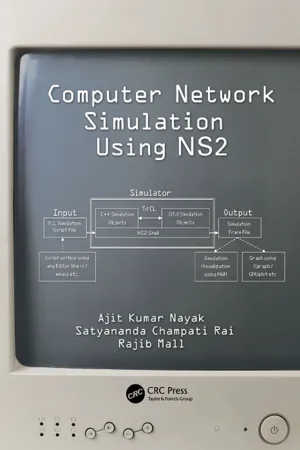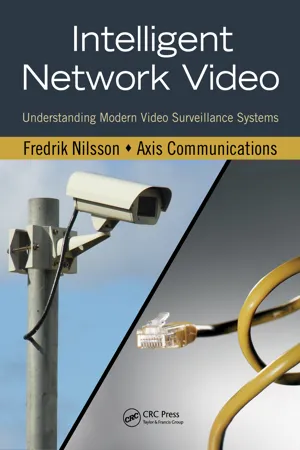Computer Science
Network Protocols
Network protocols are a set of rules and conventions that govern communication between devices on a network. They define how data is formatted, transmitted, received, and acknowledged. Examples of network protocols include TCP/IP, HTTP, and FTP, each serving specific purposes such as data transfer, web browsing, and email communication.
Written by Perlego with AI-assistance
Related key terms
10 Key excerpts on "Network Protocols"
- eBook - ePub
CompTIA Network+ Certification Guide
The ultimate guide to passing the N10-007 exam
- Glen D. Singh, Rishi Latchmepersad(Authors)
- 2018(Publication Date)
- Packt Publishing(Publisher)
https://tools.ietf.org/html/rfc6335 .Now that we have a clear understanding of the roles of ports on a system, let's dive a bit deeper in defining some of the well-known ports and their purposes on a network.Passage contains an image
Network Protocols
A network protocol defines the rules and procedures in which data communication occurs among devices over a network. Without predefined rules or procedures, the messages traversing a network would be without any particular formatting and may not be meaningful to the recipient device. To further discuss the importance of having protocols on a network/system, we will use the following analogy to provide you with a real-world situation compared to Network Protocols.Let's imagine you work for an organization, ACME Corporation, and within the company there are many policies and procedures that govern the handling of day-to-day transactions and activities within the organization. One of the most important procedures is the emergency evacuation plan. If there's an emergency within the organization, the procedure documents the rules and guidelines each employee must follow to ensure they are escorted safely out of the compound to the assembly point while the health and safety officers conduct their checks before allowing anyone to re-enter the compound. If proper procedures and guidelines didn't exist within ACME Corporation, people would be attempting to exit the compound in a haphazard manner, which may result in further safety issues. With procedures and guidelines, the employees would evacuate in a systematic manner.This is the same concept that is applied to a network. There are many different protocols that use a network to communicate with another device. Each protocol has their own uniqueness in which the information is formatted and the rules and procedures it follows while traveling on the network until it is received by the intending recipient and process upward on the OSI reference model or the TCP/IP stack. - eBook - ePub
- Marcelo Sampaio de Alencar(Author)
- 2022(Publication Date)
- River Publishers(Publisher)
- TFTP – Trivial File Transfer Protocol is one of the most elementary of all, as it has few utilities, such as time and integrity control. It is a simpler model of FTP, as it has no mechanism security, and as it is based on the UDP protocol, the integrity of your transmissions cannot be trusted. This protocol is not widely used today, but some vendors still distribute it to their customers. equipment to avoid possible incompatibilities.
8.8 The TCP/IP Protocol
TCP/IP is the most widely used network protocol today. A protocol is a set of rules to allow two or more computers to communicate. TCP/IP is a set, or a stack of protocols, as it is known. The acronym refers to two different protocols, TCP (Transmission Control Protocol) and the IP (Internet Protocol). There are many other protocols that make up the TCP/IP stack, such as FTP, HTTP, SMTP, and UDP.TCP/IP has four layers. The programs communicate with the application layer. In the application layer, you can find application protocols such as SMTP (for e-mail), FTP (for file transfer), and HTTP (for network browsing).After processing the program request, the protocol in the application layer communicates with another protocol in the transport layer, usually TCP.This layer is responsible for taking the data sent by the upper layer, dividing them into packages, and sending them to the immediately lower layer, the Internet layer. In addition, during data reception, this layer is responsible for placing packets received from the network in order (since they may arrive out of order) and also check that the contents of the packages are intact.In the Internet layer, there is the IP, which takes the packets received from the transport layer and adds information address, or IP address (the address of the computer sending the data and the address of the computer receiving the data).Then the packets are sent to the next lower layer, the Network Interface layer. In this layer, the packets are called datagrams.The network interface layer receives the packets sent by the Internet layer and sends them to the network (or receives data from the network, if the computer is receiving data). What is in that layer depends on the type of network the computer is connected to. - eBook - ePub
- Owen Poole(Author)
- 2007(Publication Date)
- Routledge(Publisher)
The TCP/IP protocol suite is a collection of protocols that were developed during the operation of the DARPAnet, the Internet forerunner. With the growth of the Internet, TCP/IP has become the de-facto standard for corporate networking. The TCP/IP protocol suite has been implemented in all operating systems in common use today, and is used as standard within the Unix and Microsoft Windows operating systems.TCP/IP stands for Transmission Control Protocol and Internet Protocol. As this implies, TCP/IP is in fact two separate but closely tied protocols, each one performing a distinct purpose.- The TCP part of TCP/IP is responsible for breaking up data or information originating from a network service into small pieces, which are often called packets, suitable for transmission over the network. TCP is connection oriented in that a connection is required before data can be transmitted. Also, error checking is carried out within TCP and so there is usually no loss during transmission when using TCP. Data is received in the correct order required for reassembly.
- The IP part of TCP/IP is responsible for the actual addressing and transmission of packets across the network. There is no guarantee of successful transmission and receipt with IP, that is the role of TCP within TCP/IP.
There are, however, other protocols used besides TCP and IP. The most common of these is a protocol called UDP, User Datagram Protocol. Whereas TCP requires a connection, UDP does not need a connection before sending data. Thus, data is streamed across a network with no attention paid to whether the information was received or not.ICMP is another protocol, and is used by the ping utility in order to check the function of a network. ICMP also enables two parts of a network to share status and error information. ICMP is short for Internet Control Message Protocol.2.6 Network addressing
In order to send data back and forth across a network, we need to assign network addresses. Unless there is to be confusion, these need to be unique within each physical network. As an analogy, just as each telephone in the world has a unique telephone number, so each computer on a network must have a unique IP address, and that includes every computer connected to the Internet! - eBook - ePub
- Ajit Kumar Nayak, Satyananda Champati Rai, Rajib Mall(Authors)
- 2016(Publication Date)
- CRC Press(Publisher)
HAPTER 2NETWORK PROTOCOLSComputer communication is a complex task. The complexity lies not only in making the communication between various machines reliable and efficient, but also supporting various media types, computers with very different hardware and speed, and the fact that various network components may be manufactured by different vendors and may need to be upgraded frequently considering that networking is a dynamic field. This complexity has been attacked by deploying two main technologies in the solution. These are standardization and layering.Computer communication is achieved through a set of protocols. The layering and standardization of protocols played a key role in the rapid acceptance and growth of computer networks. Standardization is vital to the satisfactory operation of computer networks, as different parts of a network often operate using hardware and software manufactured by different vendors.The International Organization for Standardization (ISO) formed a subcommittee named OSI (Open Systems Interconnection) to oversee the standardization work. ISO/OSI proposed a seven-layer protocol model for computer communication in 1979. A cornerstone of the ISO/OSI model is the organization of various networking protocols into well-defined layers. Layering helps to overcome the complexity of network operations and facilitates rapid evolution of Network Protocols. In the ISO/OSI seven-layer structure, each layer provides certain well-defined services to its upper layer. The ISO/OSI protocol now serves as more of a theoretical reference, whereas TCP/IP can be considered a practical implementation of the ISO/OSI protocol suite.2.1 TCP/IP Protocol SuiteThe TCP/IP protocol suite was developed by DARPA in 1969 to provide seamless communication services across an internetwork consisting of a large number of different networks. The TCP/IP protocol suite is a collection of a large number of protocols. The protocol suite is named after the two important protocols of the protocol suite: Transmission Control Protocol (TCP) and Internet Protocol (IP). A few important protocols in the TCP/IP suite and the specific protocol layer at which they operate are depicted in Figure 2.1 . The diagram also depicts the specific lower-layer protocols that are invoked by a protocol. As shown in Figure 2.1 , the TCP/IP protocol stack consists of four layers of protocols. The four layers are application layer, transport layer, internet layer, and network interface layer. The TCP/IP does not define any specific protocol for the network interface layer, but allows any of the standard protocols, Ethernet, HDLC, and Token ring, to be used at this layer. For this reason, in Figure 2.1 - eBook - ePub
- John W. Leis(Author)
- 2018(Publication Date)
- Wiley(Publisher)
4 Internet Protocols and Packet Delivery Algorithms4.1 Chapter Objectives
This chapter examines the defined standards and methods for Internet data communications, the protocols. This encompasses the data formats employed as well as the algorithms that operate on that data in order to facilitate data communication between physically separate devices. On completion of this chapter, the reader should:- Be able to define IP, TCP, and UDP, the role of protocol layers, and what functions they perform.
- Be conversant with the key elements of each protocol, such as IP addresses and TCP sockets.
- Be able to explain potential pitfalls in networking, such as congestion collapse, and know the approaches used to mitigate these problems.
- Be able to explain the principles of routing and calculate the shortest path in a routing graph.
There is a vast range of detail concerning the Internet protocols that cannot be discussed in detail in one chapter – the intent here is to explain the salient points and examine some important aspects in depth. In addition to Internet standard RFC documents, a very approachable reference is Kozierok (2005 ). Detailed explanations of the inner workings of TCP/IP are given in Stevens (1994 ), while implementation details are covered in Wright and Stevens (1995a ).4.2 Introduction
Suppose we wish to connect a number of devices together for the purposes of exchanging data. What is the best way to do this? What do we mean by “best” in this context? We might want a system that uses the available infrastructure in the most efficient manner or can transmit with the highest possible data rate and the lowest possible delay. It may have to be expandable to different physical interconnection methods, from wired to optical, wireless, and satellite, each with different characteristics. For example, a wired connection may be fast and have low delay, whereas a satellite link may be fast but experience high delays. On the other hand, a wireless link may experience interference leading to frequently lost data. If we want to have many devices interconnected, how do they “discover” each other? Finally, we may want to have a system that is scalable to a large number of interconnected devices. In short, we seek the best way to set up a network for seamless connectivity of many devices. - Eiji Oki, Roberto Rojas-Cessa, Mallikarjun Tatipamula, Christian Vogt(Authors)
- 2012(Publication Date)
- Wiley(Publisher)
For example, the Internet protocol corresponds to the network layer. TCP corresponds to the transport layer. The Internet protocol stack that includes several protocols, as shown in Figure 1.1 b, is referred to as TCP/IP. TCP/IP is being standardized by the Internet Engineering Task Force (IETF). It is widely used as the de facto standard protocol for building network equipment and internetworking. If the TCP/IP standard is used, computers can communicate with each other regardless of hardware and operating system. Figure 1.2 shows a basic philosophy of TCP/IP. In the TCP/IP philosophy, the IP core network functions simply and quickly, while the functionality of the edges surrounding the core is complex. Edges can be hosts, edge routers, network boundaries, etc. The IP network based on this philosophy is scalable and flexible. This enables different complexities at the edge. Figure 1.2 Basic philosophy of TCP/IP. Application data and customer traffic can be transmitted on the IP layer because IP is the least common denominator, as shown in Figure 1.3. IP supports transport-layer protocols such as TCP, User Datagram Protocol (UDP), Real Time Protocol (RTP)/UDP, and Stream Control Transmission Protocol (SCTP), as shown in Figure 1.4. IP works on link-layer protocols such as Ethernet, Point-to-Point Protocol (PPP) over Asynchronous Transer Mode (ATM), satellite, wireless, optical, and IP/Multiprotocol Label Switching (MPLS), as shown in Figure 1.5. Figure 1.3 IP is the least common denominator. Figure 1.4 Any transport-layer protocols on IP. Figure 1.5 Any link-layer protocols under IP. More than one network can be connected via IP, as shown in Figure 1.6. IP enables building a large-scale network where smaller networks, or subnetworks, are concatenated to build one large network. Inside each network, a node does not need to be connected with other nodes in the same network via IP- eBook - ePub
- Dimitrios Serpanos, Tilman Wolf(Authors)
- 2011(Publication Date)
- Morgan Kaufmann(Publisher)
Proprietary protocols and network architectures have been reducing steadily due to economic reasons, as well as the progress of LAN technology and the spread of the Internet. As a result, most of the protocols used today have been standardized, and a large number of companies build systems that provide these standardized protocols. Protocols are being standardized by several organizations, such as ISO [ 77 ], the Institute of Electrical and Electronics Engineers (IEEE) [ 67 ], and the ATM Forum [ 23 ]. Considering the standardization process and the resulting specifications, which have to be obeyed by networks and network systems, we need to specify the options of network and network system designers, which enable product differentiation and lead the definition of new network architectures and Network Protocols. A systematic approach to Network Protocols enables us to identify that protocol implementations are composed of three elements as shown in Figure 2-4 [ 118 ]. These three elements are: 1. Mechanisms 2. Syntax 3. System design and implementation Figure 2-4 Protocol elements. Protocol mechanisms are a protocol's methods to perform its operations, as specified. Typical mechanisms include those for flow control, error control, etc. A large body of networking and communications literature is dedicated to the study of protocol mechanisms in various protocols and environments in order to identify the appropriate methods and the specification of their parameters, for example, flow control window size, rate or credit-based flow control, and CRC polynomials for error checking [ 35, 154 ]. Protocol syntax specifies the structure of packets (data units), enabling the correct interpretation of each transmitted information bit. In a packet protocol, for example, the syntax specifies the use of headers or trailers, the fields in a header or trailer, the packet size, and so on - eBook - ePub
- Man Young Rhee(Author)
- 2013(Publication Date)
- Wiley(Publisher)
Chapter 2
TCP/IP Suite and Internet Stack Protocols
The Internet protocols consist of a suite of communication protocols, of which the two best known are the Transmission Control Protocol (TCP) and the Internet Protocol (IP). The TCP/IP suite includes not only lower-layer protocols (TCP, UDP, IP, ARP (Address Resolution Protocol), RARP (Reverse Address Resolution Protocol), ICMP, and IGMP (Internet Group Management Protocol)), but also specifies common applications such as the World Wide Web, e-mail, domain naming service, login, and file transfer. Figure 1.3 depicts many of the protocols of the TCP/IP suite and their corresponding OSI layer.It may not be important for the novice to understand the details of all protocols, but it is important to know which protocols exist, how they can be used, and where they belong in the TCP/IP suite. This chapter addresses various layered protocols in relation to Internet security, and shows which are available for use with which applications.2.1 Network Layer Protocols
At the network layer in the OSI model, TCP/IP supports the IP. IP contains four supporting protocols: ARP, RARP, ICMP, and IGMP. Each of these protocols is described below.2.1.1 Internet Protocol (IP)
The IP is a network layer (layer 3 in the OSI model or the Internet layer in the TCP/IP model) protocol which contains addressing information and some control information to enable packets to be controlled. IP is well documented in RFC 791 and is the basic communication protocol in the Internet protocol suite.IP specifies the exact format of all data as it passes across the Internet. IP software performs the routing function, choosing the path over which data will be sent. IP includes a set of rules that embody the idea of unreliable packet delivery. IP is an unreliable and connectionless datagram protocol. The service is called unreliable because delivery is not guaranteed. The service is called connectionless because each packet is treated independently from all others. If reliability is important, IP must be paired with a reliable protocol such as TCP. However, IP does its best to get a transmission through to its destination, but carries no guarantees. - eBook - ePub
Intelligent Network Video
Understanding Modern Video Surveillance Systems, Second Edition
- Fredrik Nilsson, Communications Axis(Authors)
- 2016(Publication Date)
- CRC Press(Publisher)
C HAPTER 11 Networking technologies DOI: 10.1201/9781315399904-11 Networking technology has experienced tremendous development over the past decades. Today, billions of people globally are using networking technology, tens of billions of devices are connected to networks and the internet, and the numbers are growing fast. The technology is quite complex, but most users are not exposed to this. When a user switches on their laptop, a series of networking technologies is automatically initiated to ensure that the laptop gets an Internet Protocol (IP) address and that the network communication is secure. The IP is the common denominator in network technology, and although it was originally designed for military communications, today it is also used in small home networks, enterprise local area networks (LANs), and the internet for applications such as email, web browsing, telephony, and network video. Many different protocols come into play when data are transferred securely from one networked device to another. The best way to understand how the different protocols interact is to examine the Open Systems Interconnection (OSI) communication model, as explained in the first section of this chapter. The IP is discussed extensively in the middle of the chapter, followed by a section on a topic that is becoming increasingly important as network use continues to grow, network security—sometimes referred to as cybersecurity. 11.1 OSI REFERENCE MODEL Data communication between open systems is described using the OSI Reference Model, which is composed of seven layers (Figure 11.1). Each layer provides specific services and makes the results available to the next layer. To provide a service, each layer utilizes the services of the layer immediately below it. Communication between layers occurs via specific interfaces. Each layer must follow certain rules, known as protocols, to perform its services - eBook - ePub
Practical Embedded Security
Building Secure Resource-Constrained Systems
- Timothy Stapko(Author)
- 2011(Publication Date)
- Newnes(Publisher)
CHAPTER 2 Network Communications Protocols and Built-in SecurityEmbedded systems that are connected to any network, be it the full Internet or a small LAN, have to conform to the various protocols that have been designed and implemented to keep the network running—see Figure 1 . Obviously, there must be communications protocols, including low-level (such as Ethernet or wireless technologies), medium level (such as TCP and IP), and high-level (HTTP, FTP). These protocols all work together to provide the vast array of services available from networked devices. Each of those levels, however, is subject to a number of different failures and attacks, and therefore, many protocols have been adapted to include a notion of security. For the low-level, security may be as simple as checking hardware MAC addresses against a known list, or as complicated as WPA and other wireless technologies. In the middle, there are protocols like the Secure Sockets Layer (SSL) that provide blanket security for higher level protocols. At the high level, there are various schemes that protect information, such as HTTP authentication. With all of these protocols, how can a simple, resource-constrained device hope to keep up?Figure 1 Embedded Devices on a Local Area NetworkWell, in order to answer that question, we first need to look at some of the protocols that we need to implement in order for our devices to be able to be connected to a network. Only by looking at some details will we be able to pick the protocols that are relevant to our applications—and “trim the fat” we do not need off of the protocols we do need. As it turns out, there are so many options available to us that we can pick and choose not only the protocols that we need, but also parts of those protocols that we are most interested in. This chapter will cover a number of protocols and technologies that are commonly used in networked systems. We will look at each from a high level first then dig into the details. The point of this chapter is to familiarize the reader with the technique we will use later to choose security options for a particular application. Essentially, we will look at the intended use of a protocol or technology, then what makes that technology work, and finally, if and how we can adapt that technology to suit our requirements. For now, we will only look at the protocols from a standard PC-level view. Chapter 5
Learn about this page
Index pages curate the most relevant extracts from our library of academic textbooks. They’ve been created using an in-house natural language model (NLM), each adding context and meaning to key research topics.









